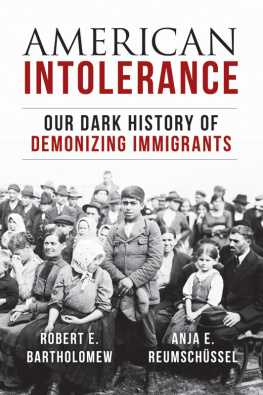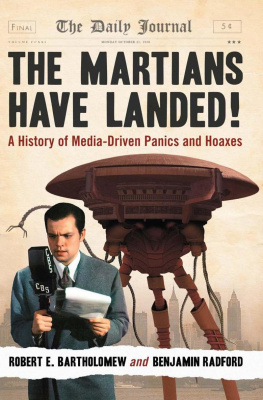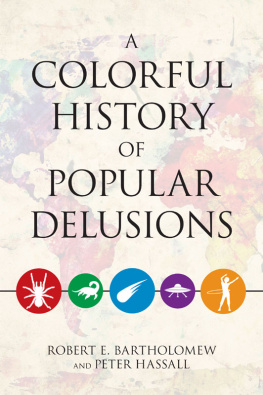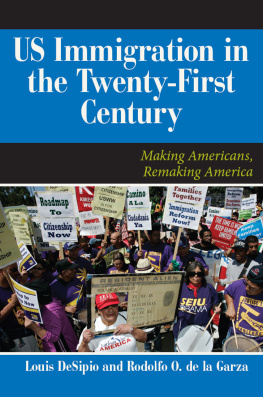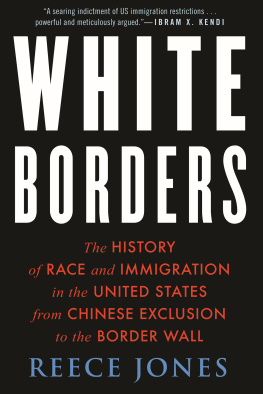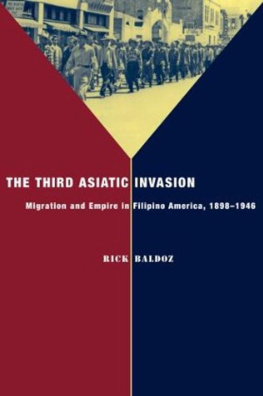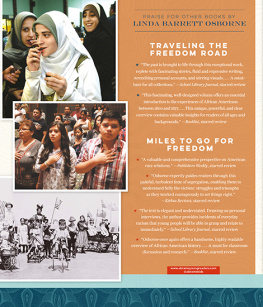ALSO BY ROBERT E. BARTHOLOMEW AND PETER HASSALL
A Colorful History of Popular Delusions
ALSO BY ROBERT E. BARTHOLOMEW AND BENJAMIN RADFORD
Hoaxes, Myths, and Manias
ALSO BY ROBERT E. BARTHOLOMEW AND GEORGE S. HOWARD
UFOs & Alien Contact

Published 2018 by Prometheus Books
American Intolerance: Our Dark History of Demonizing Immigrants. Copyright 2018 by Robert E. Bartholomew and Anja E. Reumschssel. All rights reserved. No part of this publication may be reproduced, stored in a retrieval system, or transmitted in any form or by any means, digital, electronic, mechanical, photocopying, recording, or otherwise, or conveyed via the internet or a website without prior written permission of the publisher, except in the case of brief quotations embodied in critical articles and reviews.
Trademarked names appear throughout this book. Prometheus Books recognizes all registered trademarks, trademarks, and service marks mentioned in the text.
The Internet addresses listed in the text were accurate at the time of publication. The inclusion of a website does not indicate an endorsement by the authors or by Prometheus Books, and Prometheus Books does not guarantee the accuracy of the information presented at these sites.
Cover design by Liz Mills
Cover image Everett Historical/Shutterstock
Cover design Prometheus Books
Inquiries should be addressed to
Prometheus Books
59 John Glenn Drive
Amherst, New York 14228
VOICE: 7166910133 FAX: 7166910137
WWW.PROMETHEUSBOOKS.COM
22 21 20 19 18 5 4 3 2 1
Library of Congress Cataloging-in-Publication Data
Names: Bartholomew, Robert E., author. | Reumschssel, Anja, 1983- author.
Title: American intolerance : our dark history of demonizing immigrants / Robert E. Bartholomew, Anja Reumschussel.
Description: Amherst, New York : Prometheus Books, 2018. | Includes bibliographical references and index.
Identifiers: LCCN 2018019600 (print) | LCCN 2018041566 (ebook) | ISBN 9781633884496 (ebook) | ISBN 9781633884489 (hardcover)
Subjects: LCSH: United StatesEmigration and immigrationPublic opinion. | ImmigrantsUnited StatesPublic opinion. | ImmigrantsUnited StatesSocial conditions.
Classification: LCC JV6475 (ebook) | LCC JV6475 .B27 2018 (print) | DDC 305.9/069120973dc23
LC record available at https://lccn.loc.gov/2018019600
Printed in the United States of America


Lustful priests. Dim-witted, dirty, disease-carrying Mexicans who multiply like rabbits. The filthy Chinesea poor, miserable, dwarfish race of inferior beings. The childlike, barbaric, and otherwise inferior American Indian. Japs. Nips. The evil, money-hungry Jewish conspirators who destroy everything that Christians hold sacred. The Muslims, a people marked by arrogance and blood-thirsty cruelty, who are parasitic and live by unproductive labor, petty trading, and graft. Wherever they have gone, they have exercised a very baleful influence.The litany of abusive, defamatory slurs American observers have hurled against dreamers who enter the United States from every continent but Antarctica is mind-numbing. But the authors of American Intolerance do not content themselves with an exposition on the country's benighted past; they remind us that these slurs, prejudices, and exclusionary tactics have direct relevance for the contemporary era. The country has elected a president who, during his candidacy, advocated a wall at its southern border to keep out Mexicans, and laws to exclude Muslims. Bartholomew and Reumschssel warn us about the moral panics that the irrational fear of aliens has stirred up in the American heart.
In societies around the world and very possibly throughout human history, people have become unduly distressed and concerned that, somewhere, certain categories of humanity are engaged in despicable acts. At times, under certain circumstances, this distress and concern intensifies, breaking out into more exaggerated and overt manifestations. For as long as societies have been reasonably diverse and heterogeneous, observers have noticed this interesting phenomenon, but these early observations produced no analytic traction or intellectual progenynor a distinctive designation to describe ituntil Jock Young, in 1971, and Stanley Moral panic researchers have illuminated the sudden eruption of fear of pseudo-villainous agents who have ranged from semi-somnolent Chinese opium smokers to the gleeful horror-comic-book-reading children next door.
An essential element of the moral panic is that the concern about a particular threat be disproportional or exaggerated as compared with what a clearheaded, empirical, and factual investigation would tell us. The exaggerations may pertain to the gravity of the threatthe number of victims, the seriousness of the harm, the cost of the damage to the societyor it may even involve whether such a threat exists in the first place. No one questions the right of someone to run away from a screaming, knife-wielding maniac. But the actual menace posed by many supposed threats, objectively assessed, turns out to be minor or nonexistent. Hence, the moral panics researcher is forced to be a skeptic. Is this fear based on something material? If so, what is the risk? Where is the evidence and what does it say? For the student of moral panics, data counts; facts matter. Let's do some comparisons, these theorists insist. Did the Chinese opium smokers really entice white children to take up the habit, seduce and enslave our wives and daughters, and corrupt and bring down Western civilization? Was it really true that reading comic books turned our adolescent boys into juvenile delinquents? Let's check, then let's find out why such beliefs are plausible at certain times and places. Why this issue? Why this supposed threat? Why these targets?
The most classic panics entail mobilization. Protests, demonstrations, posses, meetings, speeches. They are typically characterized by violence,threats, denunciations, and heated arguments, the formation of political action groups, and social movements. There are laws, bills, prohibitions, arrests, and imprisonments. Articles about the presumed threat are published in newspapers and magazines, the social media, fiction of the day, and angry letters to editors. In the modern era, anxious tales are broadcast about the outrage and threat of the putative menace in television news reports, and in film. Governments often jump on the bandwagon and generate budget allocations to address the problem. Police stand alert to spot and take action against the accused miscreants. In short, what do the members of a society do when they learn of the threat supposedly facing them?
What about immigrants? What makes the arrival of foreign-born folk to our shores a matter of exaggerated concern? As historian Matt Jacobson writes in Whiteness of a Different Color, in 1891, anti-Italian riots erupted in New Orleans as eleven Italians were lynched following the outcome of a murder trial that had been rigged by the local Mafia. The editorial referred to sneaking and cowardly Sicilians who are ruled by lawless passions and distinguished by cutthroat practices. Rattlesnakes, the editorial concluded, were as good citizens as they. In the 1890s, when a journalist asked an American construction worker if Italians were white, No, sir, he replied, an Italian is a Dago. In a like fashion, political cartoons published in the nineteenth century depicted Irish immigrants as hot-tempered, savage, and threatening, and looking distinctly swarthy and Negroid in countenance. Signs appeared on establishment doors: NO IRISH NEED APPLY! To many long-established Yankees of impeccable WASP ancestry, the Irish were not quite white, but rather a species of being categorically and distinctly inferior to themselves and therefore deserving of no rights. And very possibly a threat to the rest of us. Drunkards. Criminals. Papists.

